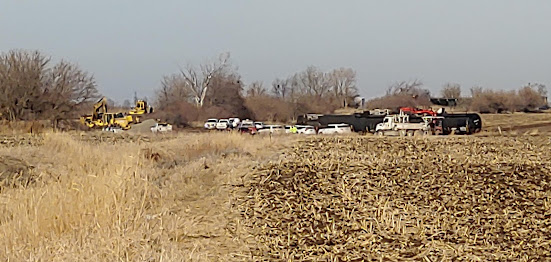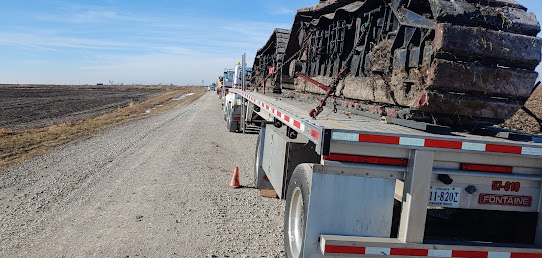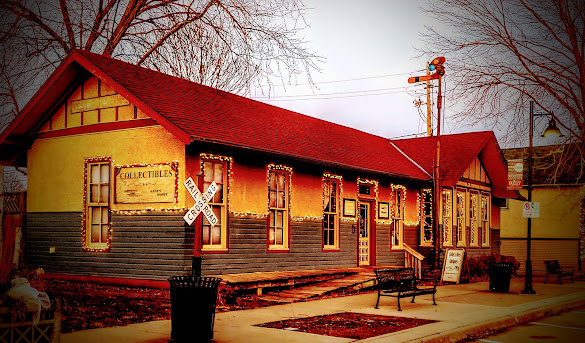Saturday, December 26, 2020
Ankeny Iowa Train Derailment
Friday, December 25, 2020
Des Moines Streetcar Friends
There are certainly a lot of railroad / railway webpages, message boards and Facebook pages out there. More enough to keep a railfan busy. I am a member of several. Pages like the Chicago and North Western Historic Society, Trains, Trains, Trains, railfans etc etc. My favorite pages are the more local pages that recognize and keep the history of railroads and particularly interurban lines alive. Many of these pages are filled with old train photos, railroad research and the priceless personal accounts of riding the rails.
One of my favorite railway facebook pages is the DesMoines Streetcar Friends a page which is dedicated to the interurban lines which brought transportation to the people who lived in central Iowa.
I have been doing my own research about the the Fort Dodge and Southern Line which ran from fort Dodge through the farm towns into Des Moines. some of the original track for that old interurban line is still in existence. And the members of the Des Moines Streetcar friends speak of the experiences of growing up along the old interurban trolley lines
Monday, December 14, 2020
Railway Photos
I take a lot of train photos around the Midwest, You can view my collection of rail photos at Railway Photos
Photos taken at Boone IowaSaturday, December 12, 2020
On The Steel Rails of My Life
On The Steel Rails of My Life
Photo by Gene Stevens, at Union RR Museum
There is a special time in every young boy's dreams
a time of summers warmth, a time of worn out jeans.
To dream of steel rails and thundering wheels
To stare down that old road and wonder how it feels
To feel the steel rails and to hear those thundering wheels
Rumbling down a road of steel from Chicago to Wisconsin and everywhere in between,
Oh, Chicago and North Western part of my boyhood dreams,
from this century's early dawn to the backyard of my home!
My Dad he was a conductor, a time he never did forget,
the green and yellow train, it stayed in his dreams until the very end.
Looking back in time to the prairie of my soul, green and yellow train take my weary body home.
To a young boys simpler life, gone forever more, steel rail roll through the time to my home.
Green and Yellow Train
By Gene Stevens
When I sat down and wrote the green and yellow train many years ago. I already knew how much influence that railroads and trains had on my life. It reminds me a little bit of the character George Bailey, who was played by Jimmy Stewart in the movie, "Its A Wonderful Life". In that we have no idea how our interactions and experiences affect us and others around us. We are totally connected to our experience, and the things that cause the experience are totally connected to us.
My earliest understanding of railroading came from my Dad who had worked for a short time with the Chicago and North Western railroad. He was both a Brakeman and a Conductor in the 1950s, But he had to quit because my Mother had serious health problems and he had to be closer to home to support his family. Being gone days at a time and on layovers were becoming impossible for him to do. So he quit the railroad. Sadly my mother passed away a few years later. I was six years old when that happened. Not having a mom was tough. And my Dad became, by necessity, a very direct and present influence in my life in her absence.
He had also served in the Navy in World War II. So our time was filled with stories of his time in the Pacific during the war, and the railroad. When he quit CNW he became a Painter. A job which was hard and didn't always pay well. He always told stories about his time with the Chicago and North Western railroad. My guess is that it was his most favorite job. Because he spoke of the railroad often. He told me about long cold nights of being away, working in rail yards, being on top of icy box cars and dealing with train wheels that had developed a "hot box", when train wheel bearings would over heat. I think he really wished he could have stayed with the railroad. This is because his eyes would light up and he would smile as he spoke about his time on the rails.
I was also really fortunate because my Dad had a lot of trust in me, and when I got old enough to start taking care of myself, he gave me a lot of freedom. I had older brothers and a sister. But I was the kid brother, and we had ten plus years between us, so they weren't always around. Which meant that my Dad had to rely on me to watch out for myself. This left me free to go out into the world pretty early.
Living in Chicago
Growing up in Chicago was a very rewarding and filled with a lot of cultural stuff. And the steel rails of the railroad played a major part in my experiences there. I would frequently ride the "L" which was an elevated and subway interurban commuter rail service which also included the "Skokie Swift", which ran into the northern suburbs of Chicago. The CNW also ran right through my neighborhood from the north burbs into the Chicago loop. It carried thousands of commuters back and fourth from their suburban homes to work in downtown Chicago.
I also watched the old green and yellow train rumble by every day, multiple times per day. When the CNW freight trains went through my north side neighborhood, I would always wave to the train crew when the caboose went by and they would always wave back. I would imagine what it would be like to work for the railroad like my Dad did. I also got to ride the CNW commuter line into downtown Chicago to shop and to go to the movie theaters. And I had the pleasure of watching part of the Skokie Swift line being built in the 1970's. I watched as track crews were laying down and securing rails by hand. Those crews worked as if they were part of one life force as their hammers swung in harmony together.
Chicago Transit Authority (CTA) Interurban Service Street Cars
As the 20th century started winding down the last of the Chicago Transit Authority (CTA) street cars would go the way of history. They were replaced by wheeled trolley buses which were equipped with a panto-graph or a trolley pole that ran off of electricity which was supplied by overhead wire systems. They took to the streets of Chicago, replacing rail based street cars.
They were an awkward and cumbersome street trolley. They were so heavy that they shook apartment buildings as they bounced along through the pot hole filled asphalt streets of Chicago. And when the trolley pole would cross overhead wire electrical junctions, the trolley pole would spark and leave a heavy smell of ozone in the air. The L (elevated) service would continue to be a viable means of transportation and still serves Chicago today.
The Navy and The Rail
In the winter of 1978 I followed in my Dad's foot steps and I joined the Navy. I would eventually be sent to Alameda California, which was the same place that my Dad had been stationed during World War II. The railroad also played a big part in my send off from Chicago. I was picked up very early in the morning by Navy recruiters and taken down to the Affee's (Armed Forces Entrance station). I completed my processing and was assigned to a group of young men and proceeded to the train station in downtown Chicago. We boarded a Chicago and North Western passenger train and headed off to the Great Lakes Naval Base in North Chicago. We arrived at Great Lakes and were met there but a gruff Company Commander. He told us to keep our mouths shut and to follow him. That was the last time that I rode a Chicago North Western Train.
Being a Cop and Operation Lifesaver
After serving in the Navy, I returned to the Chicago area and lived in the northwest suburbs of Chicago. I was home for a few months and I had been considering a career in law enforcement. I came up through the ranks, and started out as an Auxiliary Police Officer in Rosemont, Illinois and a Community Service Officer in Arlington Heights Illinois. I eventually went onto to attend the Chicago Police Academy as a full time Police Officer with the Fox River Grove Police Department in Illinois. All of these jobs had similar connections to the railroad because rail service ran through the middle of each of these towns. As I worked traffic details outside of the Horizon Center (currently known as the All State Center) a rail line ran along Mannheim Road, and when freight trains would come through interrupting the flow of traffic, as the flow would be halted at Touhy Avenue and Mannheim Road.
In 1984, I went to work for the Arlington Heights Police Department as a Community Service Officer. At the time, we were assigned to the traffic division and provided support for many traffic related incidents. This also included responding to railroad grade crossing incidents. Arlington Heights was literally divided north and south by the CNW rail system. It was both a very busy freight and commuter rail corridor. I frequently assisted on road grade crossing incidents.
In 1987 I was hired by the Fox River Grove Illinois Police Department. Fox River Grove was referred to as The Grove by locals back in the day. This title went back to an old dance hall and amusement area that sat on the Fox River in the old grove. It was very much like Arlington Heights Illinois, in that it grew up along side the CNW tracks and was also divided in half by the CNW railroad lines.
Fox River Grove had its own train station, as did Cary, Illinois which was to the west across the Fox River. The Grove had two and later three road grade crossings. The two crossings on the west side of Route 14 were very busy. And I learned a lot about the hazards of road grade crossings.
During my time there we had several rail and road grade crossing related incidents with both pedestrians and vehicles. It was a time that I learned great respect for the size and power of trains and the damage that they could do to people and things. One of the funniest things I remember about the railroad in the Grove was that we kept getting reports of car windows being smashed out of cars in the train station parking lot. This went on mysteriously for a few weeks and I parked to watch the lot there for a while, when a train went by pulling hopper cars of ballast and my squad car was pelted by ballast flying off the open hopper cars. When one hit the windshield of the squad leaving a mark. We then realized that they ballast was the culprit.
In 1991, I took my next cop job in Spring Grove, Illinois. They made me a fair offer to work there. It was a good move and I became a DARE (Drug Abuse Resistance Education) Officer. Then in 1995 I was camping in the far north of Wisconsin when I heard a radio report about a train accident that occurred in Fox River Grove Illinois. A very tragic accident at a road grade crossing there. Seven young people were killed, and many other injured while riding a school bus that was struck by a train. This incident had a huge impact on the community there, and made the surrounding area pay more attention to rail safety.
During this time, my involvement and a lifetime obsession with trains would begin. I was sent to Operation Lifesaver School. A program which was started and facilitated by Union Pacific Railroad. It was a great honor for me to participate in the program and I got to meet a lot of great people. I also got to teach young people about rail safety. In 1998, I left law enforcement and went into private security.
I had a lot of ups and downs with my life and career since that time. But I maintained a love for rails and trains .I would once again find myself wearing a badge. In 2014, I was working for a school on the North Shore of the Chicago Area, when I met a person who was a former railroad police officer and he was heavily involved in the railroad. He was also involved with starting up a police department for a shortline railway on the south side of Chicago called Ag-Valley Railroad. He invited me to apply and I was soon hired as a railroad police officer and later promoted to special agent.
Ag-Valley was very interesting. They manufactured animal feed and ran a rail yard operation at 100th Street and Torrence. They had two Track-mobiles, many tanker cars and two police vehicles. Though much of my time there was spent on foot patrolling the yard and perimeter.
I loved the rail yard. I still remember the smells and the sound of the yard work going on. The yard was also right next to the Chicago Belt Railroad Line and trains would come by frequently. For me, it was an awesome job. Ag-Valley was pretty far from home (120 miles round trip) so I was there for about a year and then took another part time cop job closer to home.
Donley's Wild West Train Engineer
In 2018 I found out that Donley's Wild West Amusements Park in Union, Illinois was looking for an Engineer for their train ride. The train at Donley's was a real train, in that it is a scale replica of a CP Huntington Engine. Its power sources was gas operated 4 cylinder flat-head engine that ran on steel rails and pulled several passenger cars. I decided to apply for the job. And much to my happy surprise... I got the job. I became a Train Engineer!!
When I started working on the engine, I was trained by the owner of Donley's Wild West Town, Mr. Larry Donley. And it just so happened that the train was Mr. Donley's train. And in my opinion, his love and dedication to this particular ride went far beyond his attention for other rides and attractions that occupied the amusement park. He loved running the engine and took particular care of the mechanical functions of the engine. For me, operating Mr. Donley's train was my dream job. The summer of 2018 turned out to be one of the best summers of my life.
From the outside, the job of Train Engineer on an amusement park Shortline Railway may seem easy, but in many ways running the engine was real work. The summer of 2018 was a typical hot and humid Midwestern summer. The CP Huntington was a full ride-in engine and the engineer compartment wrapped around the rear of the engines power plant and the cooling system radiator sat behind the engineers seat. The temperature in the operating position of the engine could reach over a hundred degrees on hot day. Which made those hotter days pretty uncomfortable. But it was well worth it. The engine was fairly powerful and had no problem pulling four cars filled with passengers. And the passengers were the reason for the job. I had a short spiel that I would say to everyone before they would board my train into the wild west. It went something this "All board! Are ya'll ready to head West? Over the Illinois Prairie, across the Mississippi River, onto Des Moines, Iowa, over to Blair, Nebraska, South to Dodge City, Kansas, Santa Fe, New Mexico, stopping in Tucson, Arizona and then straight to Tombstone, Arizona to find our fortune in the Deserts of the West." That summer probably means as much to me as my Dad's railroading experiences meant to him.
The Move to Iowa / Raccoon River Valley Railroad
In late 2018, my family and I decided to move to Iowa. I was 59 years old when we moved to Ankeny, Iowa just outside of Des Moines. I was very happy to learn that I was just a short drive from the largest railway museum in Iowa, the Boone & Scenic Valley Railroad. I go there often to ride the train or to just take pictures. I've learned a lot about local railroads and interurban rail services which served this area over the years. And I have continued to take a lot of train and railroad related pictures. I also founded the Raccoon River Valley Railway as a way to convey my photos to the public. You can find those pictures at Railway Photo
-Gene Stevens
Raccoon River Valley Railway founder
Saturday, December 5, 2020
Interurban find, at Boone scenic Railway



































































